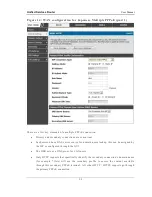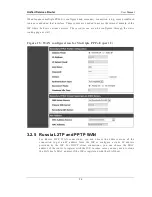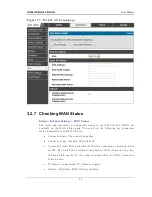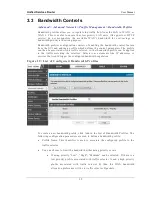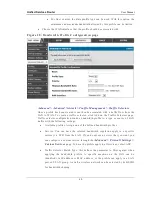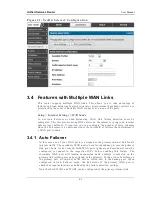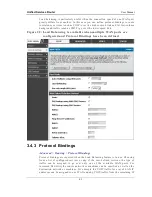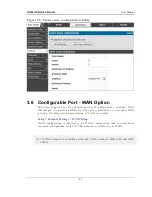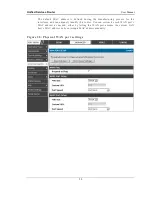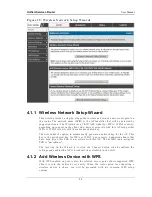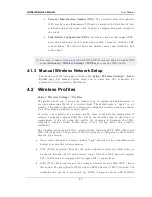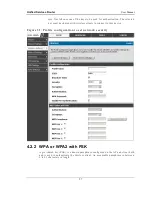
Unified Services Router
User Manual
42
Auto-Rollover using WAN port-WAN1: WAN1 is the primary internet link.
Auto-Rollover using WAN port-WAN2: WAN2 is the primary internet link.
Failover Detection Settings: To check connectivity of the primary internet link, one
of the following failure detection methods can be selected:
DNS lookup using WAN DNS Servers: DNS Lookup of the DNS Servers of
the primary link are used to detect primary WAN connectivity.
DNS lookup using DNS Servers: DNS Lookup of the custom DNS Servers
can be specified to check the connectivity of the primary link.
Ping these IP addresses: These IP's will be pinged at regular intervals to
check the connectivity of the primary link.
Retr y Interval is: The number tells the router how often it should run the
above configured failure detection method.
Failover after: This sets the number of retries after which failover is
initiated.
3.4.2 Load Balancing
This feature allows you to use multiple WAN links (and presumably multiple ISP‘s)
simultaneously. After configuring more than one WAN por t, the load balancing
option is available to carry traffic over more than one link. Protocol bindings are
used to segregate and assign services over one WAN port in order to manage
internet flow. The configured failure detection method is used at regular i ntervals on
all configured WAN ports when in Load Balancing mode.
DSR currently support three algorithms for Load Balancing:
Round Robin
: This algorithm is particularly useful when the connection speed of
one WAN port greatly differs from another. In this case you can define protocol
bindings to route low-latency services (such as VOIP) over the higher -speed link
and let low-volume background traffic (such as SMTP) go over the lower speed link.
Protocol binding is explained in next section.
Spill Over
: If Spill Over method is selected, WAN1 acts as a dedicated link till a
threshold is reached. After this, WAN2 will be used for new connections. You can
configure spill-over mode by using folloing options:
Load Tolerance: It is the percentage of bandwidth afte r which the router
switches to seconday WAN.
Max Bandwidth: This sets the maximum bandwidth tolerable by the primary
WAN.
If the link bandwidth goes above the load tolerance value of max bandwidth, the
router will spill-over the next connections to secondary WAN.
For example, if the maximum bandwidth of primary WAN is 1 Kbps and the load
tolerance is set to 70. Now ever ytime a new connection is established the bandwidth
increases. After a certain number of connections say bandwidth reached 70% of
1Kbps, the new connections will be spilled-over to secondary WAN. The maximum
value of load tolerance is 80 and the least is 20.
Protocol Bindings
: Refer Section 3.4.3 for details
Summary of Contents for DSR-250N
Page 2: ...User Manual Unified Services Router D Link Corporation Copyright 2011 http www dlink com...
Page 7: ...Unified Services Router User Manual 5 Appendix F Product Statement 214...
Page 14: ......
Page 119: ...Unified Services Router User Manual 117 Figure 74 Advanced Switch Settings...
Page 138: ...Unified Services Router User Manual 136 Figure 90 Device Status display...
Page 140: ...Unified Services Router User Manual 138 Figure 92 Resource Utilization statistics...
Page 141: ...Unified Services Router User Manual 139 Figure 93 Resource Utilization data continued...
Page 145: ...Unified Services Router User Manual 143 Figure 97 List of current Active Firewall Sessions...
Page 154: ......
Page 158: ......






